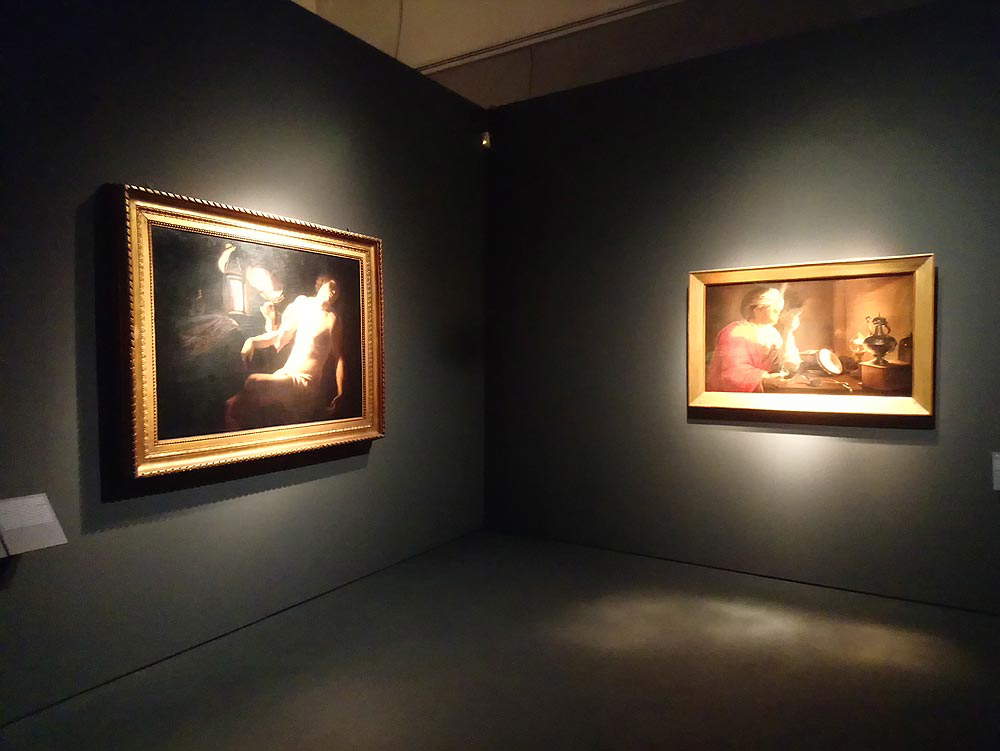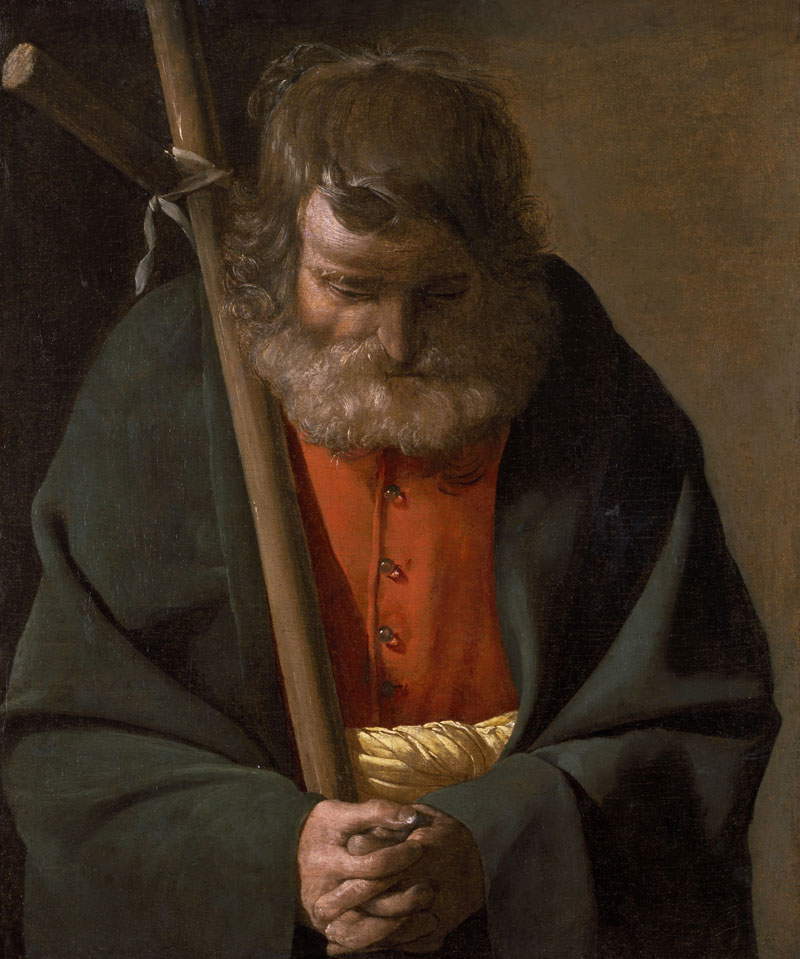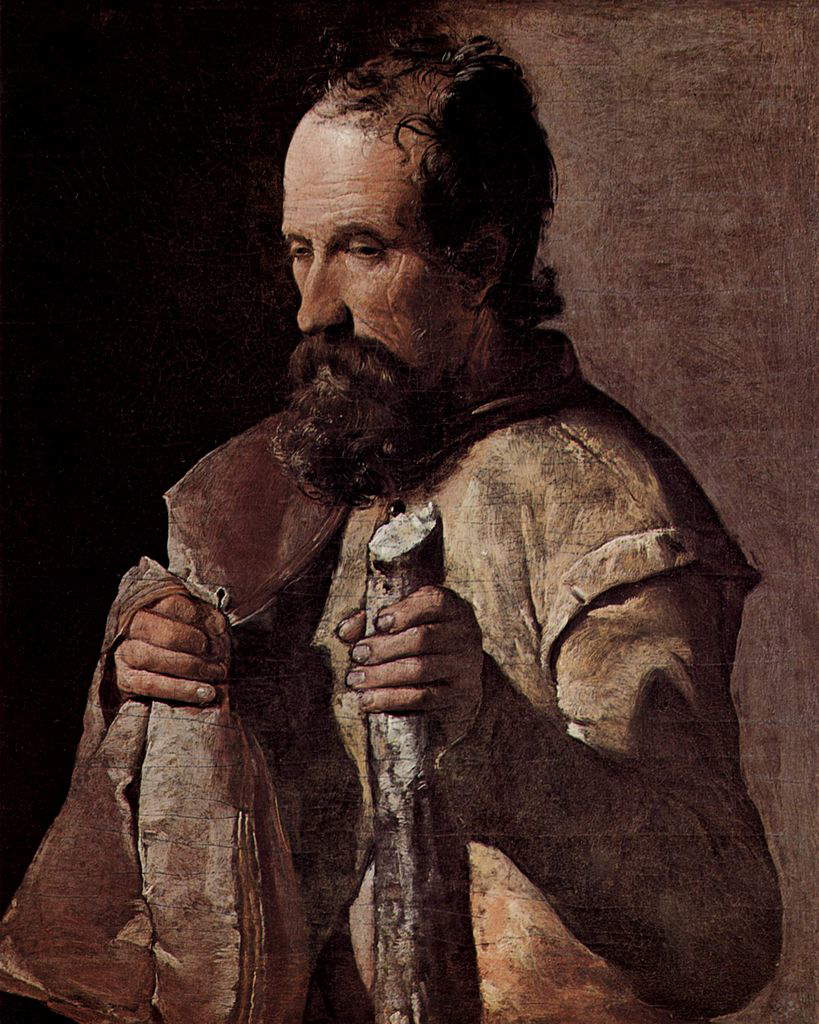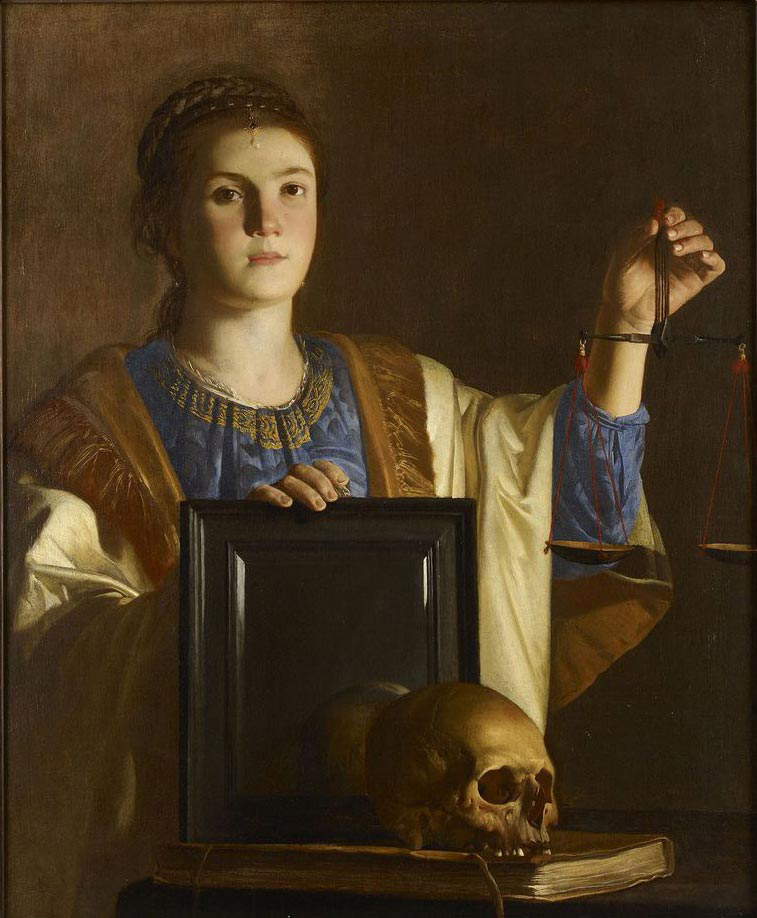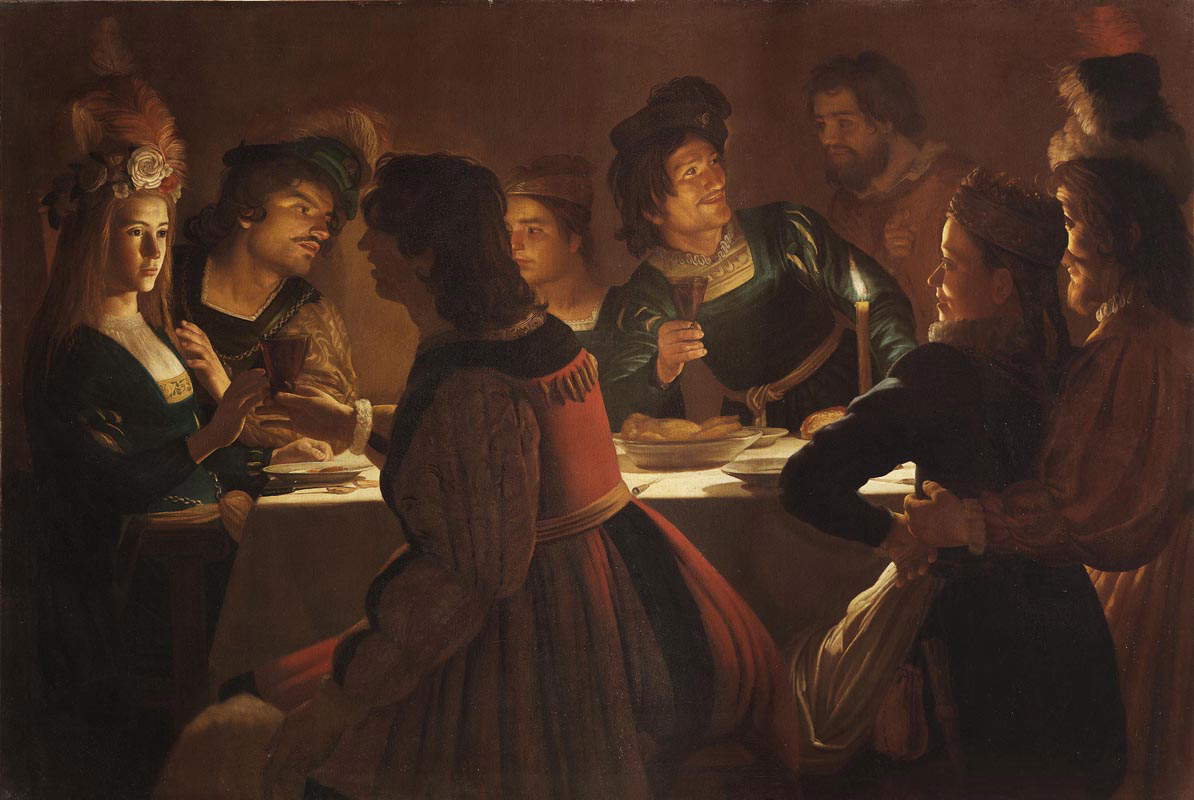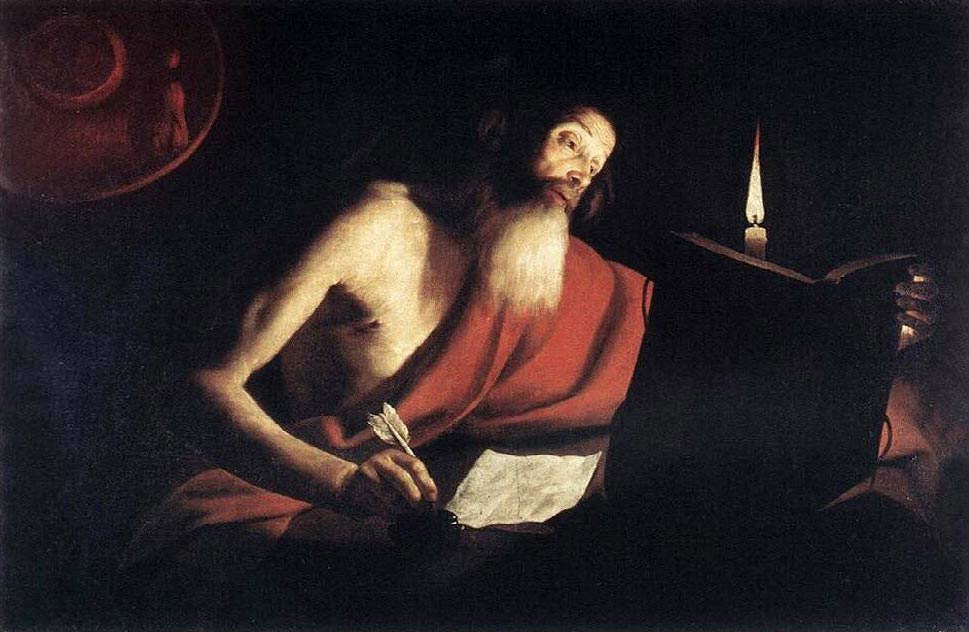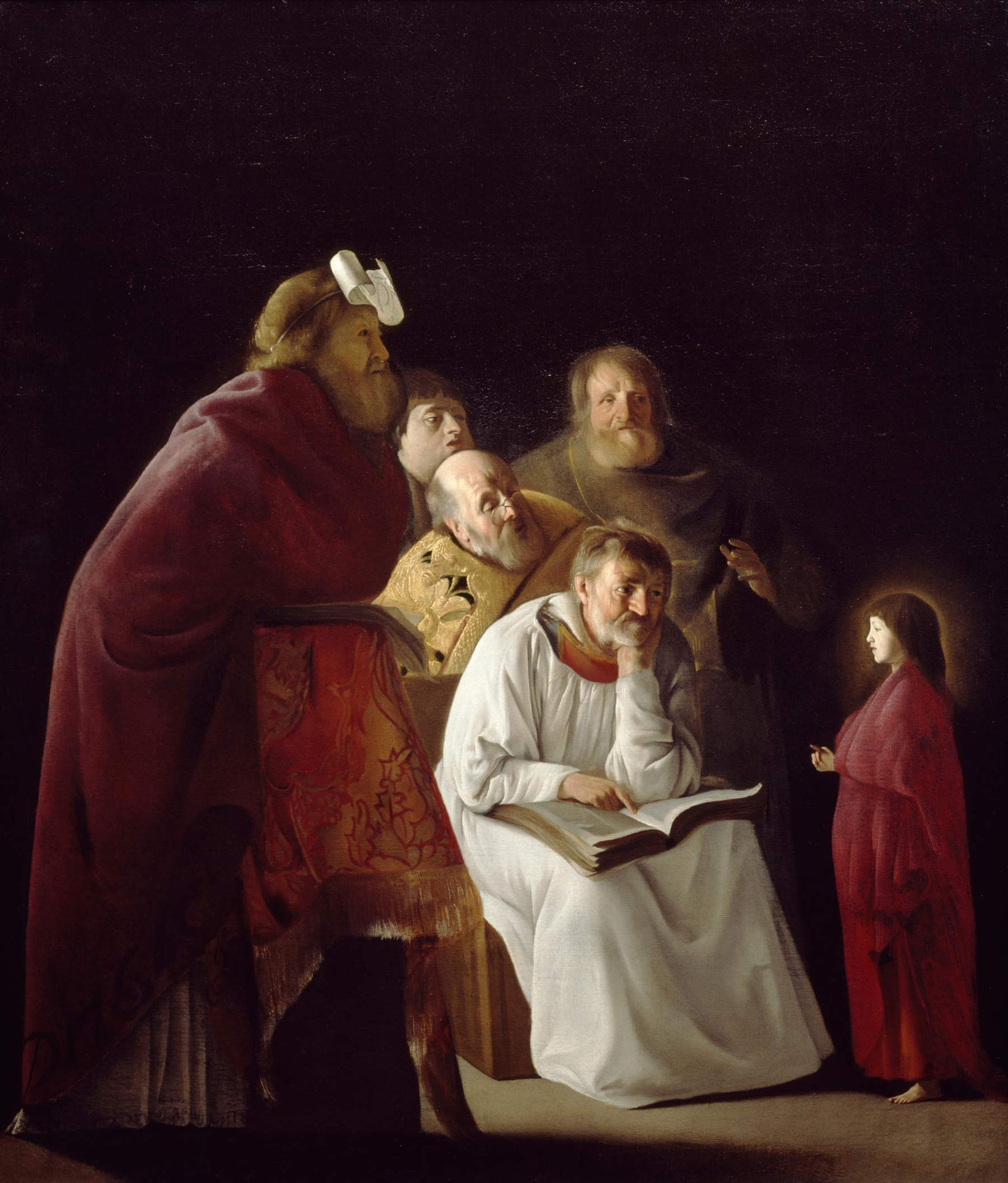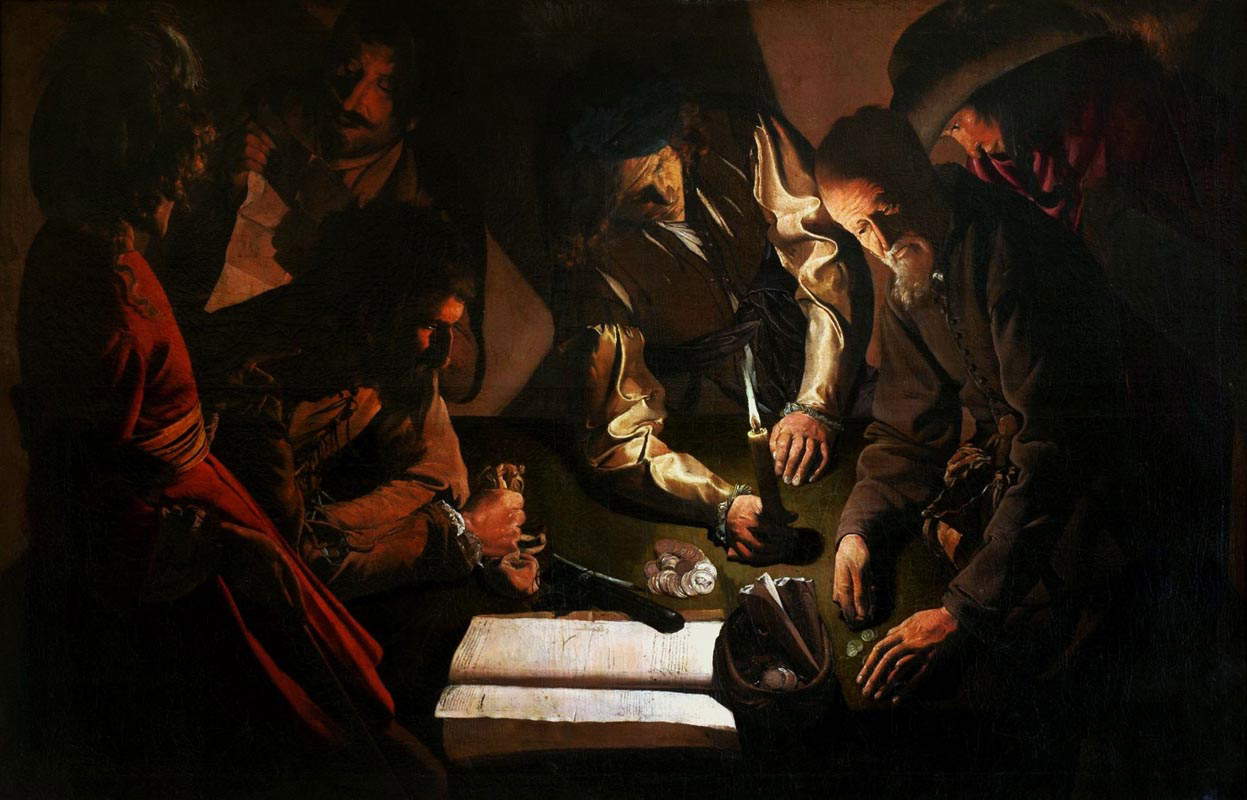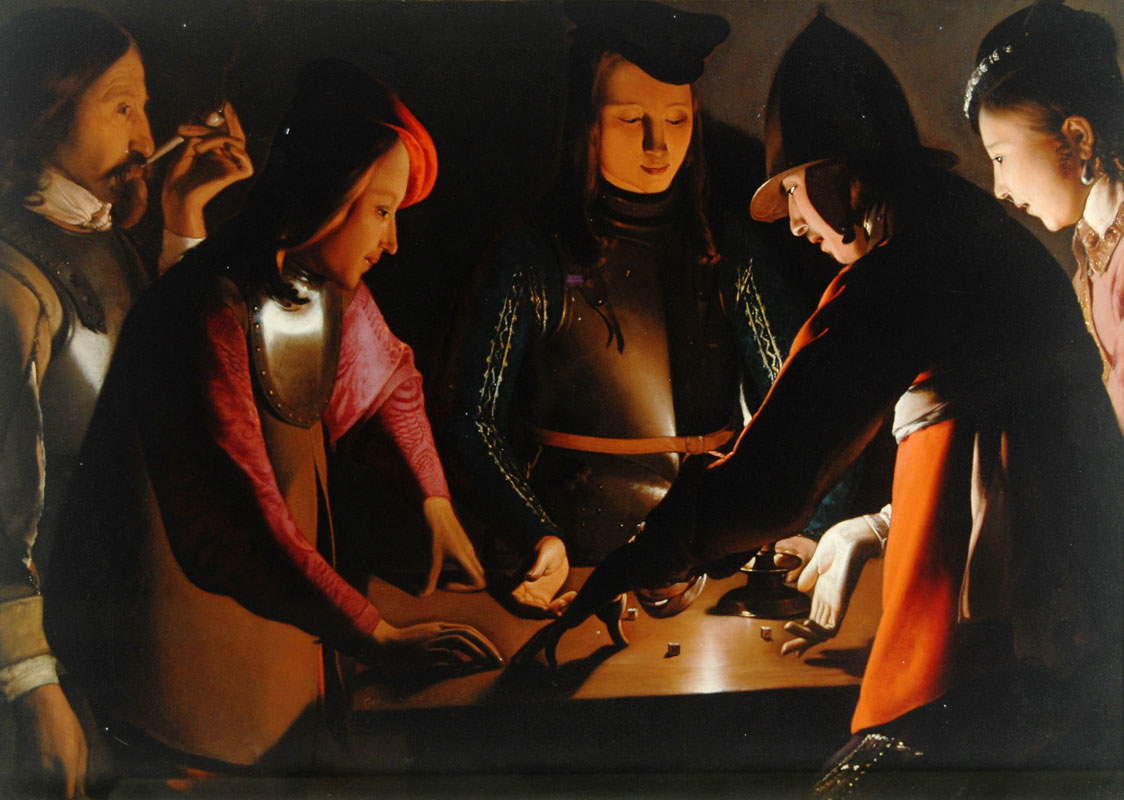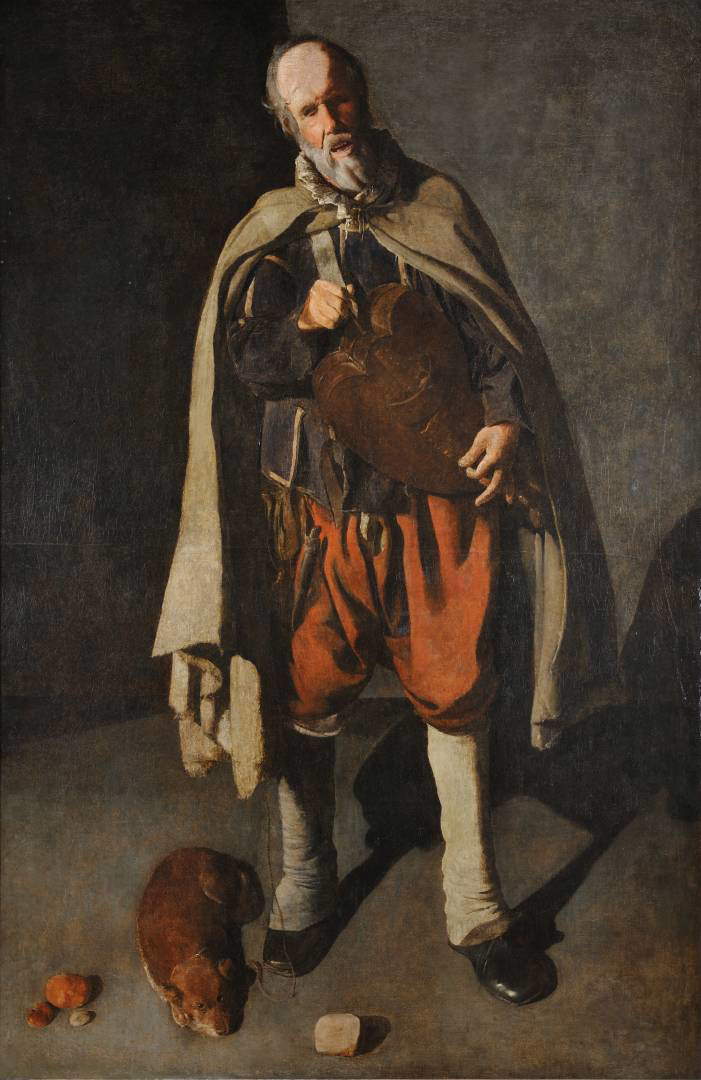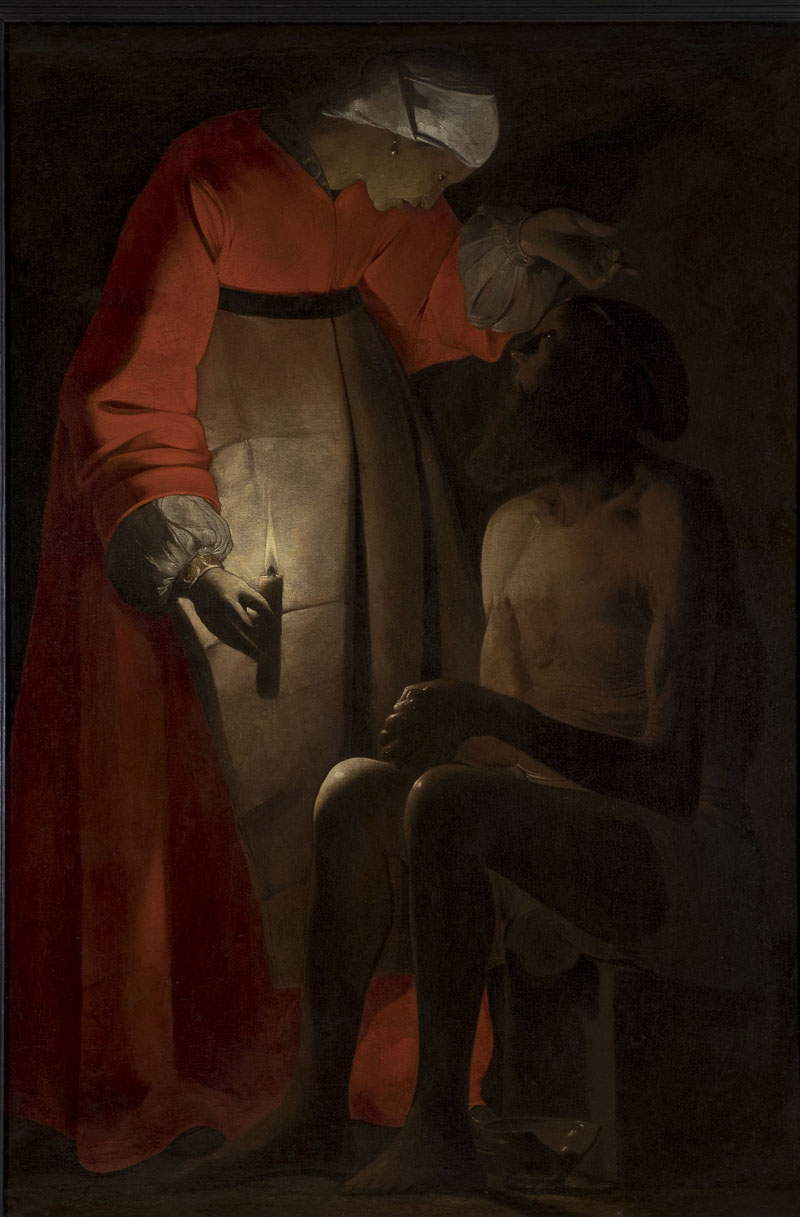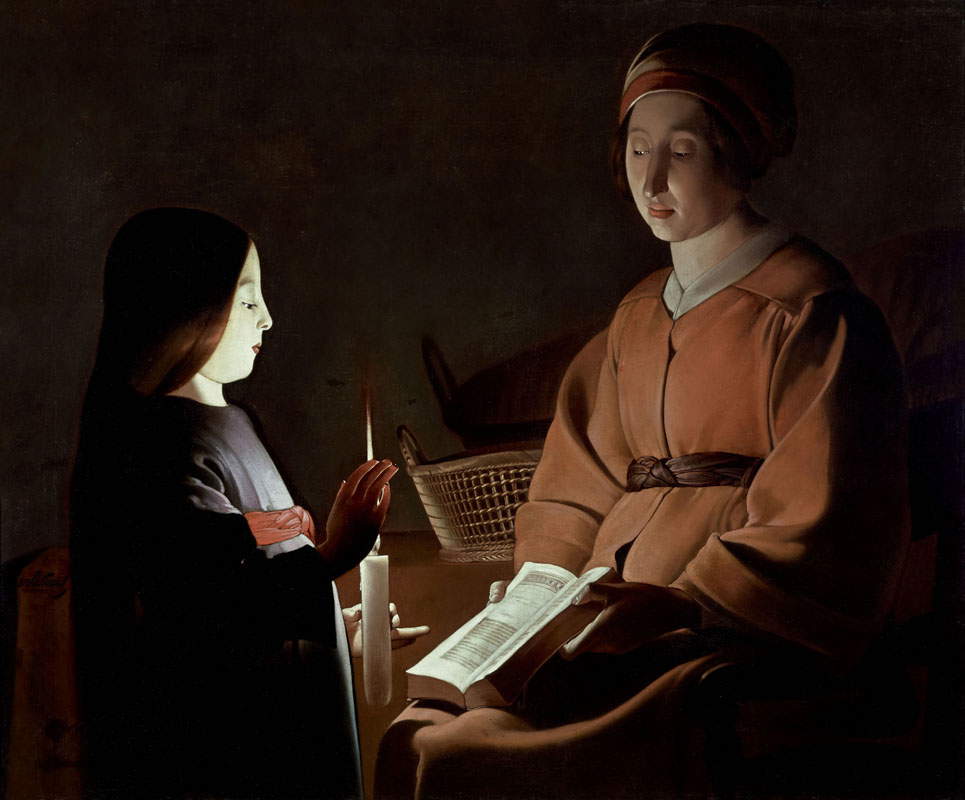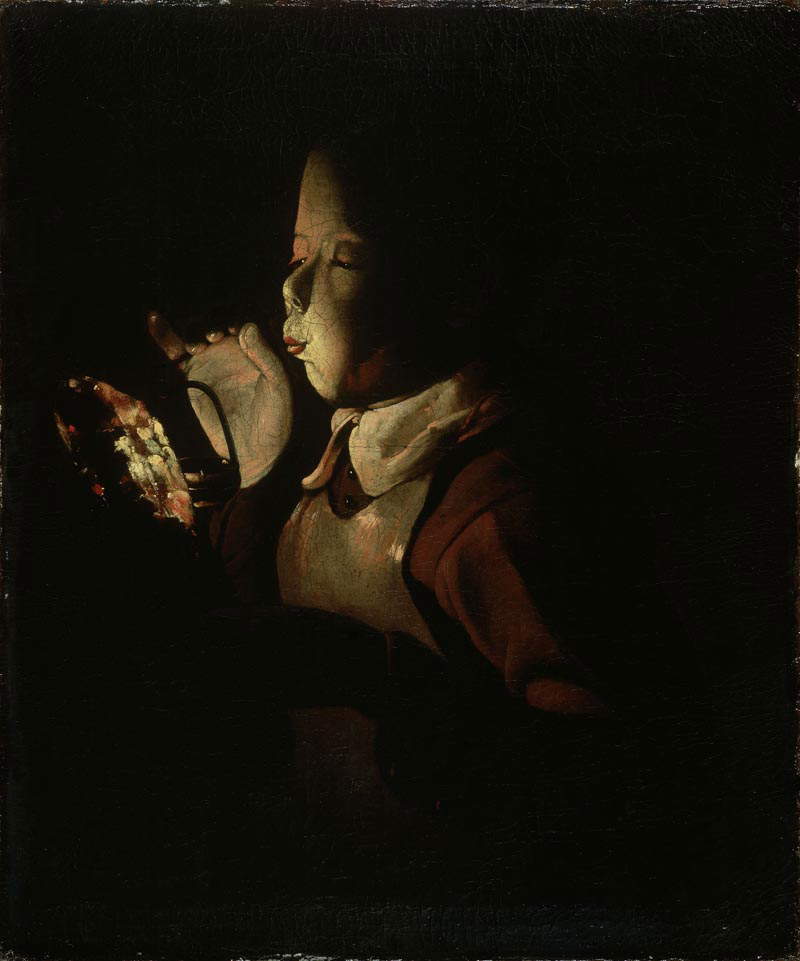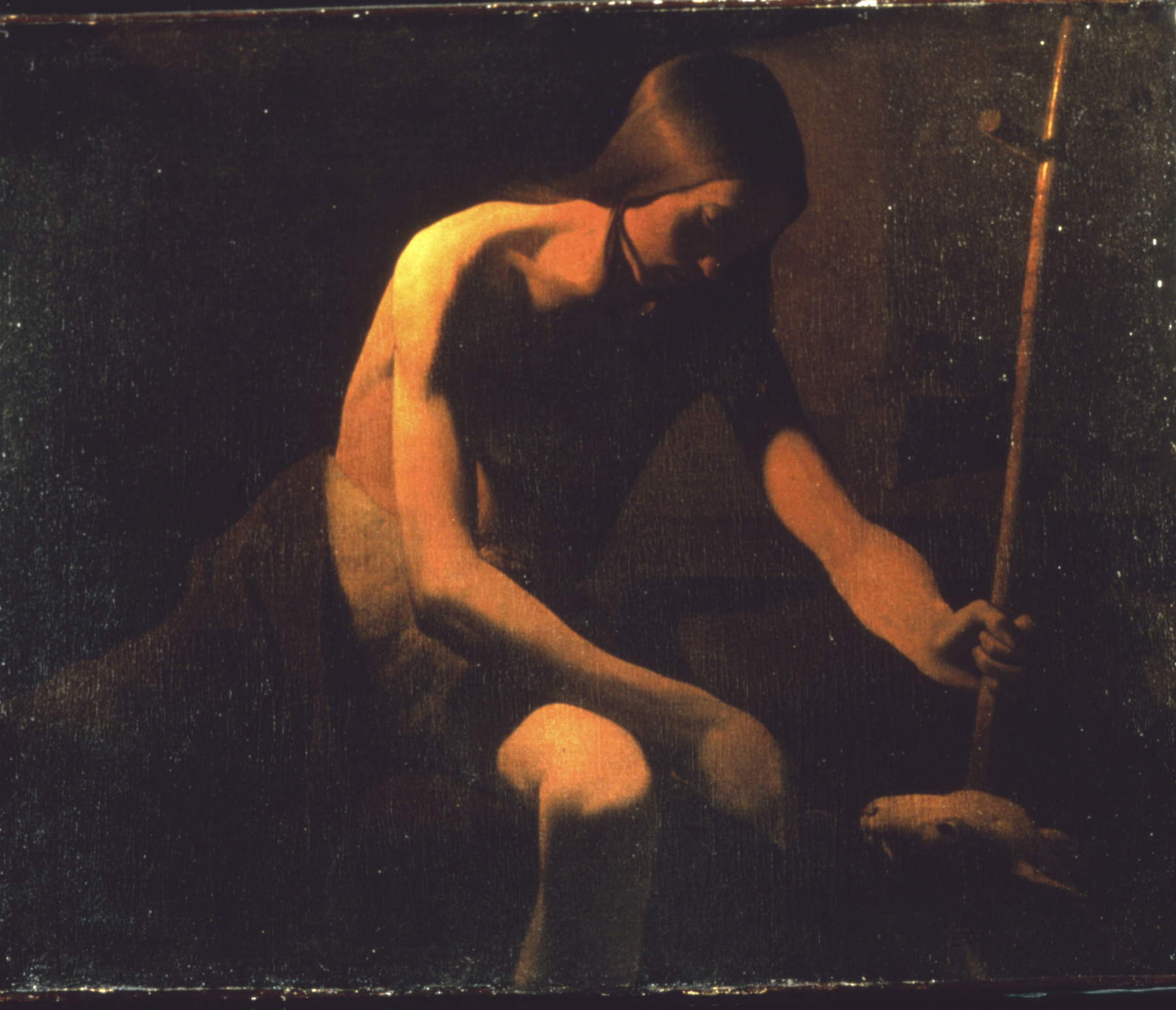by Ilaria Baratta , published on 18/07/2020
Categories: Exhibition reviews
/ Disclaimer
Review of the exhibition "La Tour. Europe of Light," in Milan, until September 27, 2020.
One of the greatest artists of seventeenth-century France, Georges de La Tour (Vic-sur-Seille, 1593 - Lunéville, 1652), was rediscovered a full three centuries later, when in 1915 German art historian Hermann Voss attributed The Newborn in the Musée des Beaux-Arts in Rennes and two other works housed in the Nantes museum, The Dream of Joseph and The Denial of Peter, to the painter Georges Dumesnil de La Tour, comparing them with archival research done in the 19th century by the Lorraine scholar Alexandre Joly. Up to that time, the three masterpieces mentioned were yes known, even mentioned by Mérimée and Stendhal, but not attributed to La Tour, but rather often juxtaposed with Dutch or Flemish artists, such as the Le Nain brothers or Gerard Seghers (Antwerp, 1591 - 1651), because of the recurring depiction of environments illuminated by artificial light sources, typical of Nordic painting and European Caravaggism. A Lorraine artist, from the periphery compared to the central Parisian milieu, had thus taken up and interpreted themes at the forefront of seventeenth-century European painting, such as the genre scene and artificial light, thus fitting into a thematic circuit common to Italian, Flemish, Dutch, Spanish and French artists. It is from this consideration that the exhibition La Tour. Europe of Light, on view at the Palazzo Reale in Milan until September 27, 2020, takes its cue, bringing together for the first time in Italy a significant nucleus of paintings by Georges de La Tour, and especially with the intention of bringing to attention the theme of artificial light in nocturnes and genre scenes in European art coeval with the artist. As well as presenting to the public a major artist about whom, however, points remain to be clarified regarding his existence and artistic connections, first among them the probable journey to Italy and the relationship with the paintings of Caravaggio (Milan, 1571 - Porto Ercole, 1610).
From the twentieth-century rediscovery of the Lorraine painter began a series of studies and research to learn more and more about La Tour’s biography and production, and of exhibitions, including the 1934 Paris exhibition entitled Les Peintres de la réalité, which marked a turning point by presenting twelve paintings attributed to the artist among a nucleus of French Caravaggesque painters. Scholars who focused on his connection to his contemporaries and to Caravaggio’s painting include Roberto Longhi, who first wrote a lengthy reflection on the seventeenth-century French Caravaggesque painters the year after the Paris exhibition, questioning the subject. And again, with the 1972 exhibition at the Orangerie, Pierre Rosenberg and Jacques Thuillier pursued research about the formation and making of some nocturnes. Investigations on the artist have continued over the years, but as mentioned, uncertain questions still remain: research activity is therefore fundamental in this regard, and at the basis of the Palazzo Reale exhibition are precisely those studies that, as Anna Ottani Cavina stated, show how “the possibilities of approaching the artist are directly proportional to the knowledge we possess of his world, and how the task of the historian is to elaborate such a detailed cartography of the period that allows us to associate facts no longer casually contemporary but in an actual relationship of necessity, insofar as they are chosen from the finally known totality of phenomena.”
A matter still much debated is that of the possible trip to Italy, through which, if so, the artist could have had direct experience of Caravaggism. The recurrence of subjects common to Caravaggio, such as the Magdalene, the barbarians, and the gypsies, suggests a probable acquaintance with Caravaggio’s works during a trip to Italy, but certain scholars, following Longhi’s own thinking, believe that La Tour was never in Italy and that he came into contact with Caravaggism thanks to copies or artists from the Nordic countries who undertook that trip to Italy instead, such as Gerrit van Honthorst (Utrecht, 1592 - 1656). The latter, as Gianni Papi reminds us in the exhibition catalog, inspired the compositional experiments of artists such as Paulus Bor (Amersfoort, 1601 - 1669) or Adam de Coster (Malines, 1586 - Antwerp, 1643), who were often approached by La Tour. The Milanese exhibition is built for this reason on comparisons between the works of the Lorraine painter and those of other artists who may have conveyed Caravaggesque themes to France, not only in the capital but also in the suburbs. Indeed, as early as the beginning of the twentieth century, scholars had already demonstrated links in the seventeenth-century era between Italian and northern European painting and how Caravaggio’s chiaroscuro transited to Spanish and Dutch painters in particular: among them, Rembrandt (Leiden, 1606 - Amsterdam, 1669), Frans Hals (Antwerp, 1580 - Haarlem, 1666), Pieter de Hooch (Rotterdam, 1629 - Amsterdam, 1684), Gerrit van Honthorst, Hendrick ter Brugghen (The Hague, 1588 - Utrecht, 1629), Adam Elsheimer (Frankfurt am Main, 1578 - Rome, 1610).

|
| Hall of the exhibition La Tour. Europe of Light |

|
| Hall of the exhibition La Tour. Europe of Light |

|
| Hall of the exhibition La Tour. Europe of Light |
As for the debated trip to Italy, he discusses it at length in his essay Gianni Papi: those who argue that La Tour was never in the peninsula appeal to the fact that there is neither any trace nor any evidence of his Italian sojourn, therefore advancing as a solution the influence of Dutch painters who returned from Rome in the second decade, especially Ter Brugghen and Honthorst. On the contrary, those who argue that La Tour was in Italy, such as Papi himself, advance as a significant element that all the Lorraine artists contemporary with the artist had that experience: to name a few, Claude Lorrain (Chamagne, 1600 - Rome, 1682), Jean Le Clerc (Nancy, 1587 - 1633), Jacques Callot (Nancy, 1592 - 1635). In his opinion, that sojourn may have taken place between 1609-10 and 1616, i.e., in the in-between time between the 16-year-old La Tour and the documentation attesting to his presence in his hometown. And in those very years in Rome he could have met Honthorst, ter Brugghen, and Ribera. The latter made in particular two series of Apostles , which in the Roman milieu of that time constituted a novelty from the iconographic point of view, since they were depicted with great expressive force: these figures reveal strong similarities with the Apostles of Albi by La Tour, both in the poses that were anything but set and official and in the composition. The Albi series is presumably the only series of apostles made by a French artist of Caravaggio’s scope. The influence of Honthorst and ter Brugghen is most noticeable in the nocturnes lit by artificial light sources. In addition, there is a strong similarity in poses between the St. John the Baptist in the Vic-sur-Seille museum and Spadarino ’s St. John the Baptist (Rome, 1585-Rome, 1652), a painting that did not move from Italy and shows a great deal of Caravaggesque influence. Another element to take into account is the presence in La Tour of themes that were very common in Rome and were first addressed by Caravaggio in the period of his initial stay in Rome: the Buona Ventura and the cheat. For a more conscious stylistic and thematic comparison with Caravaggio, an artist relevant to debating the question of La Tour’s trip to Italy even today, perhaps the presence of a few works by Merisi in the exhibition would not have hurt. However, the writer found the exhibition layout well thought out and not too dispersive, thanks in part to the decision not to crowd the walls with too many paintings, but to let the works breathe by leaving them individually on one wall or at most flanked by two or three others. In this way, the visitor’s gaze remains more focused on the individual works, enjoying the particular details more quietly. The only section in which the paintings are closer together than in the others is that of the aforementioned Apostles of Albi. La Tour completed probably at the beginning of his artistic production a complete series of half-length apostles that were to be placed around the image of Christ, as usual in the traditionalapostolado, among the first daylight works. From documentary reconstructions, it appears that the paintings came to Albi Cathedral thanks to Canon Jean-Baptiste Nualart, who allegedly recovered them in Paris from collector François de Camps. The group consisted of originals and copies; among the painter’s originals are found St. James the Lesser and St. Jude Thaddeus, St. Thomas, St. Andrew, and St. James the Greater. As already stated, the apostles are not portrayed in the canonical manner: they look humble and severe, with blackened nails typical of commoners, unkempt beards, and expressive faces.

|
| Georges de La Tour, Saint Philip (c. 1625; oil on canvas, 63.5 x 53.3 cm; Norfolk, Chrysler Museum of Art) |

|
| Georges de La Tour, Saint James the Lesser (c. 1625; oil on canvas, 66 x 54 cm; Albi, Musée Toulouse-Lautrec) |

|
| Georges de La Tour, St. Jude Thaddeus (c. 1625; oil on canvas, 62 x 51 cm; Albi, Musée Toulouse-Lautrec) |
The Milan exhibition opens very suggestively with one of La Tour’s most recurring themes, namely the Magdalene sitting in an interior lit only by the flame of a candle. On display here is the one from the National Gallery in Washington, but known are the other three versions (Metropolitan in New York, Los Angeles County Museum and Louvre). Detaching himself from the frequent sensual depiction of Magdalene, the painter depicts her seated in a nocturne, in an interior lit by candlelight, while absorbed in her meditation with one hand resting on her chin and the other on a skull, a gesture that refers to the theme of vanitas. The ephemeral nature of earthly life is accentuated in the painting by the presence of the small mirror toward which Magdalene looks and on which the skull is reflected and by the slender flame of the candle. The first section then reiterates the theme of vanitas through the works exhibited by Gerrit van Honthorst and Jacobbe (active in Rome in the third and fourth decades of the 17th century), where the skull, the mirror and the nocturnal setting by artificial light return, but in both lack the meditative aspect that in La Tour engages the viewer; in Honthorst’s painting the female figure even becomes austere. Candlelight takes center stage in the third section, where works by artists considered fundamental to La Tour’s education are displayed. In Gerrit van Honthorst’s Dinner with Spouses , diners in a nocturnal setting lit only by candlelight talk serenely, facing each other in realistic poses, while richly attired they drink and eat their meal together. Referring to the title of the work, the female figure on the left with a garland of flowers on her head is thought to be a new bride, although scholar Reznicek, with whom Gianni Papi agrees, argues that this is a mundane occasion at a tavern in Rome and that the supposed bride is instead a prostitute (Honthorst’s frequentation of prostitutes is documented). The work belongs to the first phase of the artist’s stay in Italy, between 1613 and 1614, thus in the same years in which La Tour’s trip to Rome can be assumed. Close to the style of the early Honthorst in Italy was the Master of Candlelight, (active in Rome in the third and fourth decades of the 17th century), an artist whose identity is still unknown, who used to depict figures illuminated by candles or oil lamps emerging from dense darkness, such as St. Jerome in the Barberini collection and The Capture of Christ in the Spada Gallery, both on display.
A possible diffusion of post-Caravaggesque culture in France had been advanced in the artistic production of Carlo Saraceni (Venice, 1585 - 1625), present here with the Salzburg Nativity , where in a nocturne it is the Child Jesus who emanates light, illuminating the surrounding figures; the same principle is repeated in the 12-year-old Jesus at the Temple by Paulus Bor, a Dutch artist who reworked Saracen’s use of light and illustrated small figures, in this case Christ, in large dark spaces. Bor also made his trip to Italy, and recent studies have revealed his close relationship in Rome, up to 1621, with Honthorst.
The chiaroscuro play of candlelight continues in the next section, characterized by the majority presence of works by La Tour. Here the visitor is able to focus on the artist’s interpretation of the genre scene. Scenes of nocturnes lit only by the flame of a candle intertwine with tavern scenes, the latter considered the pinnacle of seventeenth-century realism and a recurring setting in Caravaggio. La Tour sets secular depictions in the tavern, as in The Spilled Money or The Dice Players, and scenes from the Gospels, as in The Denial of Peter. In The Money P oured One can understand the old protagonist as a moneylender or a tax collector, but in any case the artist has succeeded in creating an eventful scene, where each character has his own role in the narrative: at the center is the money and all around the male figures act on each other. On the left, the man who is conversing with the one dressed in red has already paid his bill and is waving his receipt in his hand; between them sits a man who stares intently at the elderly man’s hands and holds tightly with all his strength a bag of coins, while the two figures closest to the old man watch with interest the latter’s counting of the coins. One of them then holds the candle placed on the table, from which the glow of the scene spreads. In The Dice Players, on the other hand, a scene of gambling between soldiers is depicted, watched closely by a woman whose face peeks out in the right-hand corner of the painting; significant, however, is the figure on the left who is smoking, as with her right hand she is trying to steal from the pocket of the soldier in front of her in the red hat. The work thus stages two themes very dear to both Caravaggio and his followers, namely cheating and gambling. It is also noteworthy that here the candle turns out to be hidden by the arm of the figure who is throwing dice: it pokes out the top of the flame and its light reflects off the soldiers’ armor.
In The Denial of Peter, La Tour combines in the same painting a Gospel scene, taking place at night and enacting the apostle’s betrayal, with a secular scene of a game of dice between guards. Two co-present scenes depicted distinctly: on the right the group of guards, on the left the group of St. Peter with the servant with the candle, whose flame is hidden behind the latter’s hand. The dice game foreshadows the division of Christ’s garments among the soldiers who will crucify him. The painting is one of the artist’s three signed and dated paintings (along with The Money Spilled and St. Peter and the Rooster), which made it possible to build up the author’s corpus and to consider this as his last masterpiece.

|
| Georges de La Tour, Penitent Magdalene (1635 - 1640; oil on canvas, 113 x 92.7 cm; Washington, National Gallery of Art) |

|
| Gerrit van Honthorst, Vanitas (c. 1618; oil on canvas, 104 x 84 cm; Oxford, The Ashmolean Museum) |

|
| Jacobbe (Giacomo Massa), Vanitas (c. 1630-1635; oil on canvas, 96 x 135 cm; Rome, Gallerie Nazionali d’Arte Antica) |

|
| Gerrit van Honthorst, Supper with Spouses (1613-1614; oil on canvas, 138 x 203 cm; Florence, Uffizi Gallery) |

|
| Master of Candlelight, Saint Jerome (1630-1635; oil on canvas, 105 x 138 cm; Rome, Gallerie Nazionali d’Arte Antica) |

|
| Master of Candlelight, The Capture of Christ (c. 1620; oil on canvas, 108.5 x 147 cm; Rome, Galleria Spada) |

|
| Paulus Bor, Twelve-year-old Jesus at the Temple (1630-1635; oil on canvas, 115.2 x 97.3 cm; Utrecht, Centraal Museum) |

|
| Georges de La Tour, The Money Spilled (c. 1625-1627; oil on canvas, 99 x 152 cm; Lviv, Lviv National Art Gallery) |

|
| Georges de La Tour, The Dice Players (1650 - 1651; oil on canvas, 92.5 x 130.5 cm; Stockton-on-Tees, Preston Park Museum and Grounds) |

|
| Georges de La Tour, The Denial of Peter (1620-1630; oil on canvas, 109 x 141.5 cm; Dutch Old Master Paintings) |
A case in point is represented in the exhibition by The Brawl among Beggar Musicians , which is a nocturne but deals with the theme of a brawl between humble characters: dramatic and comic features are captured at the same time. A brawl presumably triggered by a common desire on the part of the two protagonists in the center to position themselves on a more fruitful street corner: the one on the right with a bombard and a cennamella, the one on the left with a hurdy-gurdy; while the latter threateningly wields a knife, the other tries to defend himself with the bombard and by spraying his rival’s eyes with a lemon. On the left, an elderly woman, probably the woman of the hurdy-gurdy player, stares fearfully at the viewer with her mouth wide open and her hands clasped together, while on the right a fiddle player addresses a wink to the viewer, almost amused.
The depiction of beggars and hurdy-gurdy players was familiar in Lorraine, and La Tour also depicted them in his painting in the natural setting. Particularly featured in the exhibition are the two elderly figures, a man with a cane and a woman, who look like peasants but are actually dressed in the typical garb of the city bourgeoisie, and the monumental Hurdy-gurdy Player with Dog. The latter is in fact the largest painting by La Tour that has come down to us and belongs to the artist’s early period, characterized by Caravaggio-like realism.
Painting the Night is the title chosen to encapsulate the works in the sixth section of the exhibition, and indeed the theme of artificial light in La Tour’s production of domestic interiors at night is reiterated here through a number of significant paintings. In The Job Mocked by His Wife, the space appears too small to contain the monumental figure of the woman inciting Job to rebel against his fate and God: the constricting environment further emphasizes the drama of the scene, and in all this the candle, creating a backlight and reflection effect, amplifies the woman’s gesture and the suffering depicted in the scene. In an opposite manner, domestic quiet is proposed in the Frick Collection’sEducation of the Virgin , where the candle flame in the little girl’s hands strongly illuminates the girl’s face, the book being read by her, and, in a more subdued manner, the woman in front of her. The viewer experiences in front of this work a feeling of religious silence. Another aspect of the artist’s production related to a genre scene and the presence of an artificial light source in a nocturne is the depiction of young men and maidens intent on lighting fires, lamps or pipes: on display here is the Young Man Blowing on a B reath of Fire, which highlights the contrast between the light source illuminating part of the face of the person blowing and the surrounding dense darkness that does not allow one to distinguish anything about the environment.

|
| Georges de La Tour, The Brawl between Beggar Musicians (c. 1625 - 1630; oil on canvas, 85.7 x 141 cm; Los Angeles, The J. Paul Getty Museum) |

|
| Georges de La Tour, The Hurdy-Gurdy Player with Dog (1622 1625; oil on canvas, 186 x 120 cm; Bergues, Musée du Mont-de-Piété) |

|
| Georges de La Tour, Job Mocked by his Wife (c. 1650; oil on canvas, 145 x 97 cm; Epinal, Musée départemental d’Art ancien et contemporain) |

|
| Georges de La Tour (and workshop?), The Education of the Virgin (c. 1650; oil on canvas, 83.8 x 100.3 cm; New York, The Frick Collection) |

|
| Georges de La Tour, Young Man Blowing on an Ashlar (c. 1640; oil on canvas, 61 x 51 cm; Dijon, Musée des Beaux-Arts) |

|
| Georges de La Tour (copy from?), Saint Sebastian Cured by Irene (c. 1640-1650; oil on canvas, 105 x 139 cm; Orléans, Musée des Beaux-Arts) |

|
| Georges de La Tour, Saint John the Baptist in the Desert (c. 1649; oil on canvas, 81 x 101 cm; Vic-sur-Seille, Musée départemental Georges de La Tour) |
The last two sections each focus on a single painting, namely Saint Sebastian being cared for by Irene and Saint John the Baptist in the Desert. The former refers to an episode that occurred during the artist’s career: La Tour gave King Louis XIII a painting of a “Saint Sebastian at night,” which was so much appreciated by the sovereign that he eliminated all the paintings hanging in his bedroom to display it alone. At least ten versions of this work are known (the one on display is from Orléans), so it has come to be assumed that the copies refer to the painting that entered the French royal collections around 1639, when La Tour was granted the title in Paris of ordinary painter to the king. In this version, Irene finds the body of Saint Sebastian and cares for it with affection, concentration, and devotion. The candlelight delicately illuminates the saint’s body while also giving the scene a tone of sensuality.
Finally, St. John the Baptist in the Desert, a masterpiece of the artist’s late production, makes explicit the formal simplification of the composition by eliminating every other element. The figure of the saint is portrayed with essentiality as he is feeding a small lamb with blades of grass. With his curved back illuminated by an artificial light source, which is not visible on the scene, and his long, smooth hair, the young man turns his meditative gaze to the animal and holds a tall, thin wooden cross with his left hand. The exhibition concludes, therefore, with one of the painter’s last paintings, made around 1649, and it is singular because unlike his typical nocturnes he has chosen here not to depict the source of light, which has so far always been present in the works on display. Essentiality has eliminated one of the recurring elements in his nocturnal settings, neither a candle nor a lamp.
In a kind of parallelism, the exhibition had opened with a solitary figure in meditation, Magdalene, and now closes with another figure in meditation, alone with the sole company of a lamb.
The accompanying catalog features several contributions from experts: Francesca Cappelletti reflects on La Tour and his time, Pierre Rosenberg traces the history of the painter’s twentieth-century rediscovery, Jean-Pierre Cuzin dwells on La Tour as a European painter, Gail Feigenbaum illustrates the artist’s style, particularly chiaroscuro. Dimitri Salmon reflects on the issue of antique copies, Gianni Papi addresses the relationship between La Tour and Italy and the possible journey to the peninsula, Rossella Vodret with Giorgio Leone and Carlo Giantomassi with Donatella Zari deal with the works in Santa Maria in Aquiro, Matteo Mancinelli addresses the issue of mysticism, and finally Manfredi Merluzzi narrates what was the perception of Europe in the late sixteenth and first half of the seventeenth century. Significant contributions to the advancement of studies on La Tour and the still debated issues. In addition, for the purpose of a comprehensive understanding of La Tour’s entire corpus, images of works not shown in the exhibition but related to the themes and subjects depicted have been included in the catalog, such as other hurdy-gurdy players, apostles, other depictions of St. Jerome or St. Joseph, the Good Fortune, coffins, various versions of the Penitent Magdalene and St. Sebastian curated by Irene.
For the first time, many works by one of the leading French artists of the seventeenth century, who, as we have seen, is considered among the leading Caravaggesque painters of France, have been brought together in Italy; and undoubtedly this exhibition constitutes a significant step in reaching a greater understanding of the painter based on careful studies and research that is constantly developing.
Warning: the translation into English of the original Italian article was created using automatic tools.
We undertake to review all articles, but we do not guarantee the total absence of inaccuracies in the translation due to the program. You can
find the original by clicking on the ITA button. If you find any mistake,please contact us.


